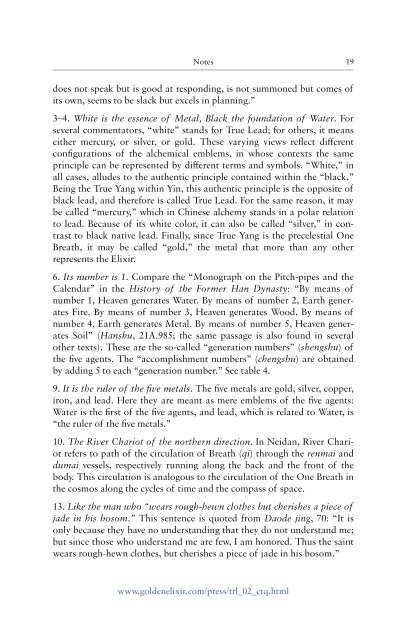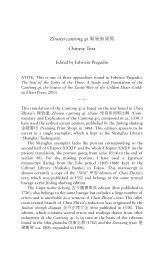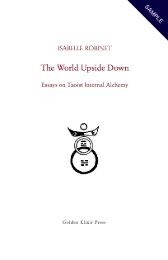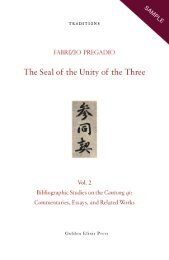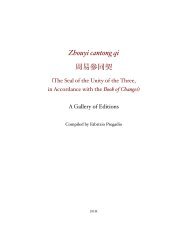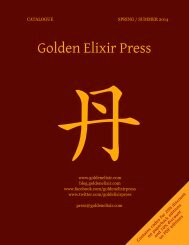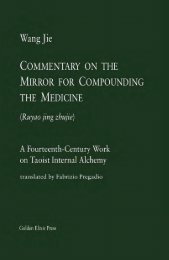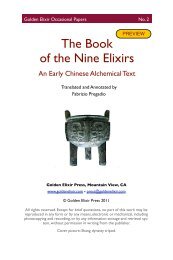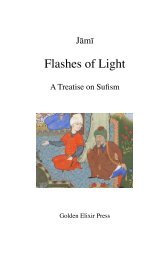The Seal of the Unity of the Three - The Golden Elixir
The Seal of the Unity of the Three - The Golden Elixir
The Seal of the Unity of the Three - The Golden Elixir
You also want an ePaper? Increase the reach of your titles
YUMPU automatically turns print PDFs into web optimized ePapers that Google loves.
Notes 19<br />
—————————————————————————————————————————<br />
does not speak but is good at responding, is not summoned but comes <strong>of</strong><br />
its own, seems to be slack but excels in planning.”<br />
3–4. White is <strong>the</strong> essence <strong>of</strong> Metal, Black <strong>the</strong> foundation <strong>of</strong> Water. For<br />
several commentators, “white” stands for True Lead; for o<strong>the</strong>rs, it means<br />
ei<strong>the</strong>r mercury, or silver, or gold. <strong>The</strong>se varying views reflect different<br />
configurations <strong>of</strong> <strong>the</strong> alchemical emblems, in whose contexts <strong>the</strong> same<br />
principle can be represented by different terms and symbols. “White,” in<br />
all cases, alludes to <strong>the</strong> au<strong>the</strong>ntic principle contained within <strong>the</strong> “black.”<br />
Being <strong>the</strong> True Yang within Yin, this au<strong>the</strong>ntic principle is <strong>the</strong> opposite <strong>of</strong><br />
black lead, and <strong>the</strong>refore is called True Lead. For <strong>the</strong> same reason, it may<br />
be called “mercury,” which in Chinese alchemy stands in a polar relation<br />
to lead. Because <strong>of</strong> its white color, it can also be called “silver,” in contrast<br />
to black native lead. Finally, since True Yang is <strong>the</strong> precelestial One<br />
Breath, it may be called “gold,” <strong>the</strong> metal that more than any o<strong>the</strong>r<br />
represents <strong>the</strong> <strong>Elixir</strong>.<br />
6. Its number is 1. Compare <strong>the</strong> “Monograph on <strong>the</strong> Pitch-pipes and <strong>the</strong><br />
Calendar” in <strong>the</strong> History <strong>of</strong> <strong>the</strong> Former Han Dynasty: “By means <strong>of</strong><br />
number 1, Heaven generates Water. By means <strong>of</strong> number 2, Earth generates<br />
Fire. By means <strong>of</strong> number 3, Heaven generates Wood. By means <strong>of</strong><br />
number 4, Earth generates Metal. By means <strong>of</strong> number 5, Heaven generates<br />
Soil” (Hanshu, 21A.985; <strong>the</strong> same passage is also found in several<br />
o<strong>the</strong>r texts). <strong>The</strong>se are <strong>the</strong> so-called “generation numbers” (shengshu) <strong>of</strong><br />
<strong>the</strong> five agents. <strong>The</strong> “accomplishment numbers” (chengshu) are obtained<br />
by adding 5 to each “generation number.” See table 4.<br />
9. It is <strong>the</strong> ruler <strong>of</strong> <strong>the</strong> five metals. <strong>The</strong> five metals are gold, silver, copper,<br />
iron, and lead. Here <strong>the</strong>y are meant as mere emblems <strong>of</strong> <strong>the</strong> five agents:<br />
Water is <strong>the</strong> first <strong>of</strong> <strong>the</strong> five agents, and lead, which is related to Water, is<br />
“<strong>the</strong> ruler <strong>of</strong> <strong>the</strong> five metals.”<br />
10. <strong>The</strong> River Chariot <strong>of</strong> <strong>the</strong> nor<strong>the</strong>rn direction. In Neidan, River Chariot<br />
refers to path <strong>of</strong> <strong>the</strong> circulation <strong>of</strong> Breath (qi) through <strong>the</strong> renmai and<br />
dumai vessels, respectively running along <strong>the</strong> back and <strong>the</strong> front <strong>of</strong> <strong>the</strong><br />
body. This circulation is analogous to <strong>the</strong> circulation <strong>of</strong> <strong>the</strong> One Breath in<br />
<strong>the</strong> cosmos along <strong>the</strong> cycles <strong>of</strong> time and <strong>the</strong> compass <strong>of</strong> space.<br />
13. Like <strong>the</strong> man who “wears rough-hewn clo<strong>the</strong>s but cherishes a piece <strong>of</strong><br />
jade in his bosom.” This sentence is quoted from Daode jing, 70: “It is<br />
only because <strong>the</strong>y have no understanding that <strong>the</strong>y do not understand me;<br />
but since those who understand me are few, I am honored. Thus <strong>the</strong> saint<br />
wears rough-hewn clo<strong>the</strong>s, but cherishes a piece <strong>of</strong> jade in his bosom.”<br />
www.goldenelixir.com/press/trl_02_ctq.html


